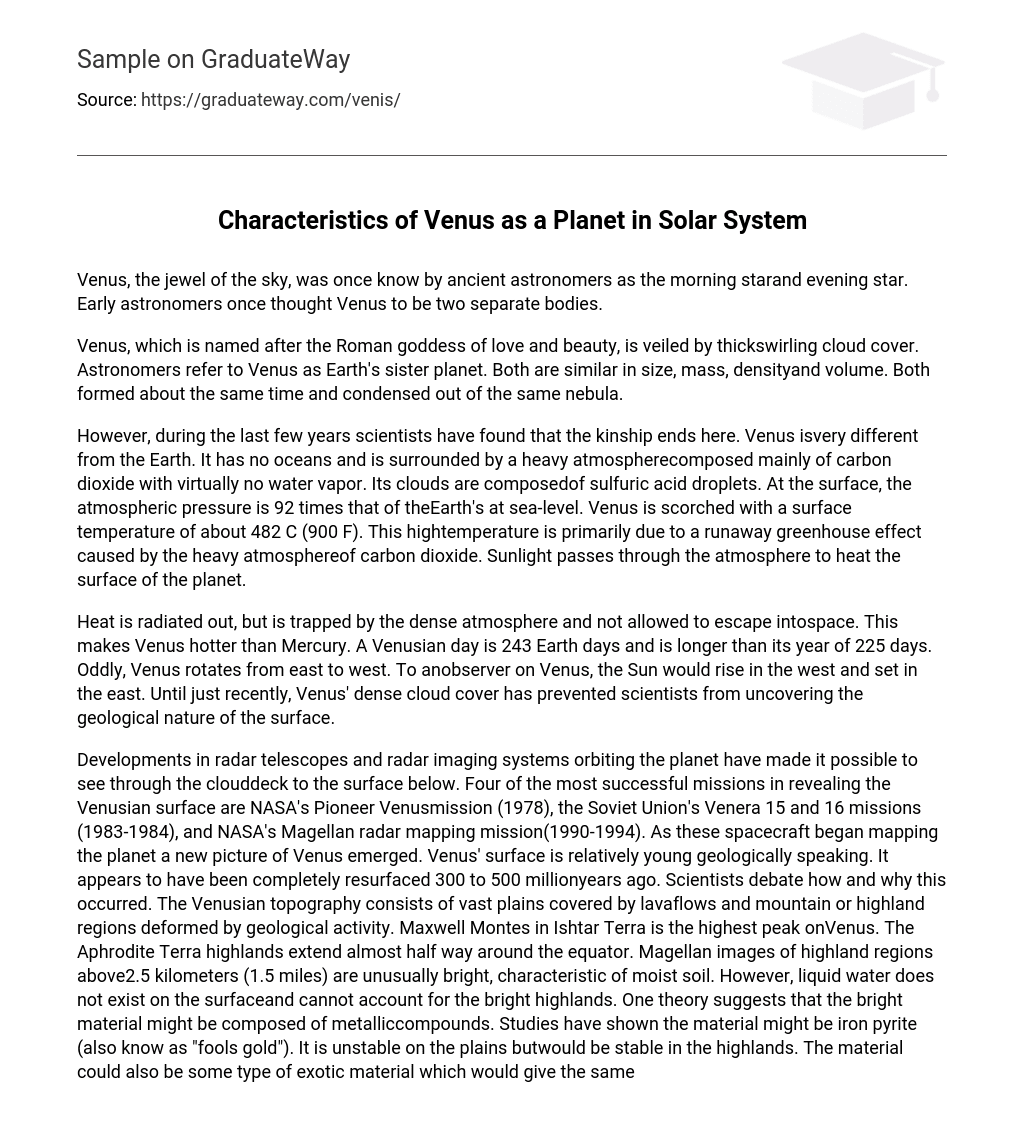Venus, the jewel of the sky, was once know by ancient astronomers as the morning starand evening star. Early astronomers once thought Venus to be two separate bodies.
Venus, which is named after the Roman goddess of love and beauty, is veiled by thickswirling cloud cover. Astronomers refer to Venus as Earth’s sister planet. Both are similar in size, mass, densityand volume. Both formed about the same time and condensed out of the same nebula.
However, during the last few years scientists have found that the kinship ends here. Venus isvery different from the Earth. It has no oceans and is surrounded by a heavy atmospherecomposed mainly of carbon dioxide with virtually no water vapor. Its clouds are composedof sulfuric acid droplets. At the surface, the atmospheric pressure is 92 times that of theEarth’s at sea-level. Venus is scorched with a surface temperature of about 482 C (900 F). This hightemperature is primarily due to a runaway greenhouse effect caused by the heavy atmosphereof carbon dioxide. Sunlight passes through the atmosphere to heat the surface of the planet.
Heat is radiated out, but is trapped by the dense atmosphere and not allowed to escape intospace. This makes Venus hotter than Mercury. A Venusian day is 243 Earth days and is longer than its year of 225 days. Oddly, Venus rotates from east to west. To anobserver on Venus, the Sun would rise in the west and set in the east. Until just recently, Venus’ dense cloud cover has prevented scientists from uncovering the geological nature of the surface.
Developments in radar telescopes and radar imaging systems orbiting the planet have made it possible to see through the clouddeck to the surface below. Four of the most successful missions in revealing the Venusian surface are NASA’s Pioneer Venusmission (1978), the Soviet Union’s Venera 15 and 16 missions (1983-1984), and NASA’s Magellan radar mapping mission(1990-1994). As these spacecraft began mapping the planet a new picture of Venus emerged. Venus’ surface is relatively young geologically speaking. It appears to have been completely resurfaced 300 to 500 millionyears ago. Scientists debate how and why this occurred. The Venusian topography consists of vast plains covered by lavaflows and mountain or highland regions deformed by geological activity. Maxwell Montes in Ishtar Terra is the highest peak onVenus. The Aphrodite Terra highlands extend almost half way around the equator. Magellan images of highland regions above2.5 kilometers (1.5 miles) are unusually bright, characteristic of moist soil. However, liquid water does not exist on the surfaceand cannot account for the bright highlands. One theory suggests that the bright material might be composed of metalliccompounds. Studies have shown the material might be iron pyrite (also know as “fools gold”). It is unstable on the plains butwould be stable in the highlands. The material could also be some type of exotic material which would give the same results butVenus is scarred by numerous impact craters distrubuted randomly over its surface. Small craters less that 2 kilometers (1.2miles) are almost non-existent due to the heavy Venusian atmosphere. The exception occurs when large meteorites shatter justbefore impact, creating crater clusters. Volcanoes and volcanic features are even more numerous. At least 85% of the Venusiansurface is covered with volcanic rock. Hugh lava flows, extending for hundreds of kilometers, have flooded the lowlandscreating vast plains. More than 100,000 small shield volcanoes dot the surface along with hundreds of large volcanos. Flowsfrom volcanos have produced long sinuous channels extending for hundreds of kilometers, with one extending nearly 7,000Giant calderas more than 100 kilometers (62 miles) in diameter are found on Venus. Terrestrial calderas are usually onlyseveral kilometers in diameter. Several features unique to Venus include coronae and arachnoids. Coronae are large circular tooval features, encircled with cliffs and are hundreds of kilometers across. They are thought to be the surface expression ofmantle upwelling. Archnoids are circular to elongated features similar to coronae. They may have been caused by molten rockseeping into surface fractures and producing systems of radiating dikes and fractures.
Bibliography:





